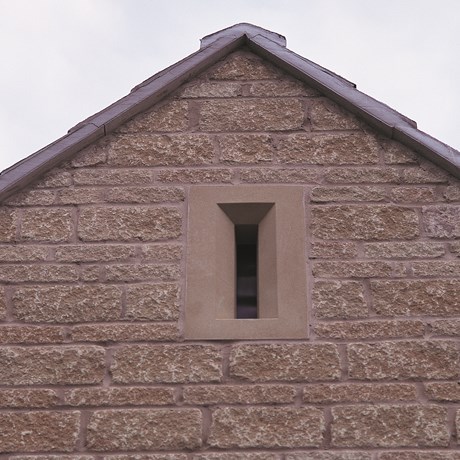Gable
A gable is a section of wall located at the end of a pitched roof, between the edges of the intersecting pitches. It is usually triangular and extends from the eaves to the ridge, although the shape and detailing depends on the particular structural system used for the roof. The term ‘gable wall’ (or ‘gable end’) is used to refer to the gable and the whole wall below it.
In classical architecture, a gable was referred to as a pediment.
As well as being designed to be aesthetically pleasing, a gable should be capable of preventing water from entering the intersection between wall and roof. This can be done by carrying the roof out over the top of the end walls, or by raising the end walls above roof level to form a parapet capped with a waterproof coping.
The latter design can take several different forms in terms of its outline. Where roofs are of a steep pitch, gables are sometimes decorated with stepped or curved forms, ornamented with grotesques, statues, scrolls, and so on. A common example is a crow-stepped gable, also known as a stepped gable or corbie step, which takes the form of a stair-step pattern at the top of the stone or brick parapet wall which projects above the roofline. They can be designed with integral windows or vents (as in the above image).
Gables tend to be an inappropriate design for buildings located in hurricane regions since the wind pressures exerted on the gable end can cause the roof to fail.
Rather than constructing gables from masonry, they can be formed by prefabricated spandrel panels. These panels can be installed quickly by crane, and mean that roofing contractors can complete the wall elements under the roof rather than having to get brick or block layers to return to site.
[edit] Related articles on Designing Buildings
Featured articles and news
RTPI leader to become new CIOB Chief Executive Officer
Dr Victoria Hills MRTPI, FICE to take over after Caroline Gumble’s departure.
Social and affordable housing, a long term plan for delivery
The “Delivering a Decade of Renewal for Social and Affordable Housing” strategy sets out future path.
A change to adoptive architecture
Effects of global weather warming on architectural detailing, material choice and human interaction.
The proposed publicly owned and backed subsidiary of Homes England, to facilitate new homes.
How big is the problem and what can we do to mitigate the effects?
Overheating guidance and tools for building designers
A number of cool guides to help with the heat.
The UK's Modern Industrial Strategy: A 10 year plan
Previous consultation criticism, current key elements and general support with some persisting reservations.
Building Safety Regulator reforms
New roles, new staff and a new fast track service pave the way for a single construction regulator.
Architectural Technologist CPDs and Communications
CIAT CPD… and how you can do it!
Cooling centres and cool spaces
Managing extreme heat in cities by directing the public to places for heat stress relief and water sources.
Winter gardens: A brief history and warm variations
Extending the season with glass in different forms and terms.
Restoring Great Yarmouth's Winter Gardens
Transforming one of the least sustainable constructions imaginable.
Construction Skills Mission Board launch sector drive
Newly formed government and industry collaboration set strategy for recruiting an additional 100,000 construction workers a year.
New Architects Code comes into effect in September 2025
ARB Architects Code of Conduct and Practice available with ongoing consultation regarding guidance.
Welsh Skills Body (Medr) launches ambitious plan
The new skills body brings together funding and regulation of tertiary education and research for the devolved nation.
Paul Gandy FCIOB announced as next CIOB President
Former Tilbury Douglas CEO takes helm.
UK Infrastructure: A 10 Year Strategy. In brief with reactions
With the National Infrastructure and Service Transformation Authority (NISTA).























